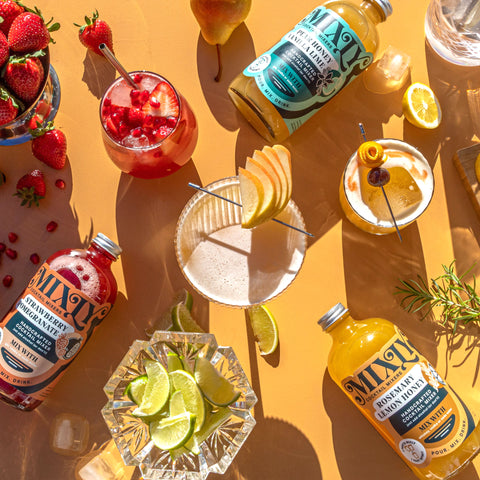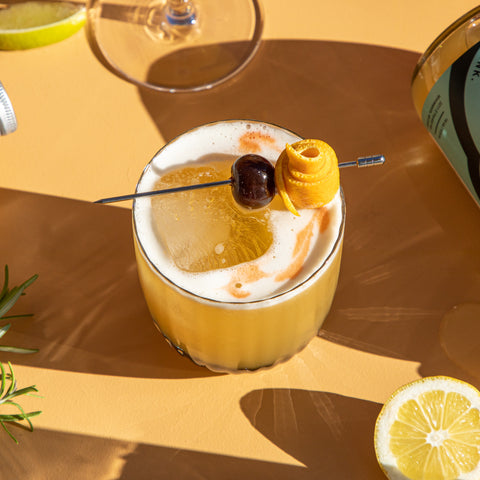Whether you're a seasoned pro or an at-home bartender, having the right tools is essential for making cocktails successfully. Even if you enjoy reading and searching about the latest and greatest mixology trends, the number of decisions you need to make can feel overwhelming when you start looking to build a bartender kit.
In this guide, we'll break down all the must-haves when seeking out a mixology bartender kit to take your drink-making game to the next level.
Let's dive in, shall we?
What To Consider When Buying A Mixology Bartender Kit
There are tons of mixology bartender kits out there, but only some will give you the tools you need. The main thing to consider before purchasing is this:
Know thyself! Think about how much use these items will get and whether they'll be for professional or personal use. If you plan on mixing up cocktails at home, then go ahead and purchase just one great bar toolset that has everything you'd need. But if you're a mixologist bartending at a bar, you might need to buy specific tools for different purposes, like having one toolkit for behind the bar and another to take home. Think about how often you plan on using your mixology bartender kit (and how much wear and tear it may face) before making any big purchases.

Essential Tools To Include In Your Mixology Bartender Kit
When building your collection of tools, you'll need to have a few essential, "must-have" items. Here is a list of the most critical tools to make sure you include in your mixologist bartender kit:
- Jiggers
- Cocktail Shakers
- Cocktail Strainers
- Muddlers
- Bar Spoons
- Citrus Press
- Cutting Board
- Paring Knife
- Y-Peeler
- Wine Key
- Tongs
- Speed Pourers
Jiggers
These are for measuring cocktail ingredients. Jiggers ensure accuracy in everything you make, which is imperative in successful mixology. There are two commonly used jiggers: a single jigger and a double jigger. Double jiggers have an hourglass shape, with each end having a bowl for different measurements. A single jigger only has one basin and often looks like a shot glass or a miniature measuring cup with different graduations showing the various measures it contains. Single jiggers may also be called single-level jiggers.There are also several style varieties to consider. A double jigger is the most utilized among professional mixologists today, so we'll turn our focus there when it comes to available styles.
- Japanese Precision Jigger: This narrow style has two measuring basins on each end. This variation is arguably the most preferred among bartenders today for its slender design and functionality.
- 1930s Leopold Bell Jigger: While this style typically measures similar to its Japanese counterpart, it has a bit more weight to it. The measuring basins are broad and deep instead of tall and slender. Some bartenders prefer the weight and feel of this style—it's genuinely a matter of preference.
Cocktail Shakers
If you're planning to make mixologist-approved libations, adding in a set of cocktail shakers (or two) is of critical importance when building your bartender kit. Many bartenders end up using different versions of certain tools for specific purposes, but it often comes down to personal preference. There are two types of shakes to consider:
- Boston Shaker: Boston shakers utilize two separate tins, typically a 12-ounce tin and a 28-ounce tin. They can both be tin, or one can be tin and the other glass. Whatever the material, the most important thing is that the two fit inside one another with ease to create a tight seal for shaking. Many mixologists prefer the tin-on-tin variety as it helps chill the cocktail properly and minimizes the risk of the two tins sticking together.
- Cobbler Shaker: Cobbler shakers have three parts, which are a tin, a built-in strainer top, and a cap for sealing. Many home bartenders prefer this style because it's user-friendly. However, those who work busy nights behind the bar tend to think it's inefficient. There is also one more style called the Parisian shaker, but it is essentially the same thing as a Cobbler but without a cap.
Cocktail Strainers
You'll notice a theme start to emerge when building your mixology bartender kit—different styles of every tool. This variation is what can make it challenging to know what's needed. But we'll continue to break them all down so you can make the best decisions for your kit.
When it comes to strainers, you'll find the following styles of the tool: Hawthorne, Julep, and Fine-Mesh. Each serves a different purpose.
- Hawthorne Strainer: This style is best used for shaken drinks because the coils on the strainer fit snuggly into the confines of the shaker tin. The tight fit helps catch things you don't want falling into your final product, such as citrus pulp, herbs, and egg white.
- Julep Strainer: The julep strainer looks like a curved disc with a handle, and it has a bunch of tiny holes in the steel. This version is frequently used for stirred drinks to separate the ice from spirit-forward libations.
- Fine-Mesh Strainer: Using a fine-mesh strainer is essential for top-notch mixology. The technique (typically called double-straining or fine-straining) for using one typically entails pouring a cocktail from a shaker tin using one of the previously mentioned strainers and also through a fine-mesh strainer. Doing so removes any smaller particles like seeds, ice chips, or specks of herbs that you do not want in your cocktail. Double-straining can also enhance a drink's overall texture.
Muddlers
A muddler is a straightforward bartender tool. They're often made from wood or stainless steel, and it smashes herbs, fruits, sugar cubes, and more to release and incorporate their flavors into a drink.
Bar Spoons
A bar spoon looks like a long-handled teaspoon, and they too can come in several variations.
- American Bar Spoon: The American bar spoon typically has a small red cap on the top, and the handle is twisted approximately one-third of the way up the spoon's body. It then flattens out.
- European Bar Spoon: The European style also has twisted curves on the handle along with a muddling tool on its end. It can be a bit awkward to adjust to, but it can be a convenient tool over time.
- Japanese Bar Spoon: Once again, the Japanese style is frequently preferred amongst many mixologists. Why? It has a nice, weighted feeling thanks to the teardrop shape at the end of the long, twisted spoon. It also tends to be longer than the other two styles, which makes it a good fit for bartenders of any level.
Whatever style you choose, practicing your technique will help you improve your ability to stir cocktails properly. Make sure to hold it in your fingers like how you hold a pencil, keep the back of the spoon touching the mixing glass as you stir, and roll the spoon as you stir around the glass's outer rim. It's all in the circular motion of the wrist!
Citrus Press
A citrus press is for squeezing fresh juice! Utilizing the freshest ingredients possible is paramount to making high-quality drinks. Incorporating a tool to make juice is critical when building your mixology bartender kit. Choosing a citrus press over other options will serve you better in the long run. Who knows, you may have to take your equipment on the road and squeeze fresh juice on the fly! Also, who wants to clean and lug around hefty juicers that take up a ton of space?
All that said, if you need to make a large volume of cocktails, that heavy-duty juicer will be a much more practical option. As we mentioned earlier—know thyself! Just the tools that best suit your needs.
Cutting Board & Paring Knife
If you're going to make fresh juice, you need to be able to cut your citrus! Having a cutting board and knife readily available will serve numerous purposes—especially when it comes to your garnish game.
Y-Peeler
Speaking of garnish game, you'll need a quick and easy way to peel citrus for the many drinks that call for twist garnishes. Using a y-peeler that is sturdy, reliable, and sharp is your best bet. Y-peelers are inexpensive, lightweight, typically safe to use and minimize the amount of pith left on your citrus peels.
Wine Key
What does a wine key, do you ask? It opens wine! It is another core component of a well-stocked mixology bartender kit. It's also light and compact, making it easy to tuck away and take with you on the go. In addition to opening wine, the foil cutter can help cut seals on other types of bottles, and some of them are handy for opening beer bottles that don't come with twist-off caps.
Tongs
Bar tongs have many uses, which is why they must be included in your kit. Most importantly, tongs can help you pick out ice and can also help you keep dirty fingers from touching ingredients that go into consumable products (like your delicious mixology cocktails).
Speed Pourer
If you've ever been inside of a bar, you have seen a speed pourer. These are stainless steel (which is preferred) or plastic spouts that go into the opening of liquor bottles to allow precise, controlled, fast pouring when building drinks. Including a few in your mixology bartender kit will be incredibly useful for streamlined mixing.
Carrying Bag
Having a carrying case will be incredibly important if you want to take your mixology skills on the road. Nowadays, there are several stylish options that you can use to travel safely with your tools. The carrying bags come in numerous shapes, styles, colors, and more, but they will each contain specially curated pockets, and holders made for essential mixology bartender tools.
Concluding Tips For Creating A Mixology Bartender Kit
Now that you know the necessities for building your mixology bartender kit, keep a few of the following tips in mind when making your purchases:
- Check reviews and ratings before purchasing anything, or ask your fellow cocktail connoisseurs.
- Remember to consider the use your tools will receive—make purchases that will stand up to wear and tear.
- Ensure quality; it bears repeating! Look for thick, durable shaker tins, stainless steel jiggers, and high-quality strainers and spoons.
- Stay within your budget. You may not be able to get every top-of-the-line product right away, and that's okay. Even the best tools wear out at some point. Just be sure to buy products that will last and not be replaced every other week.
- Make sure all the components of your kit are made with safe, toxic-free materials. Doing so will keep you safe and everyone you serve safe too.
Keep this guide in mind, and you will be set up for success. If you want to include some ready-made mixers in your mixology bartender kit, stop on over and check out Mixly's mixers as you prepare to impress with your cocktail-making expertise.



